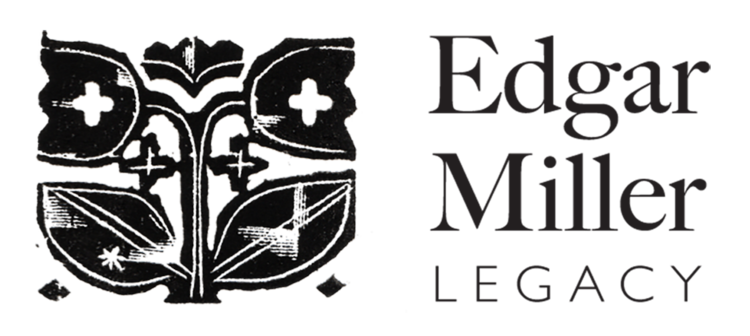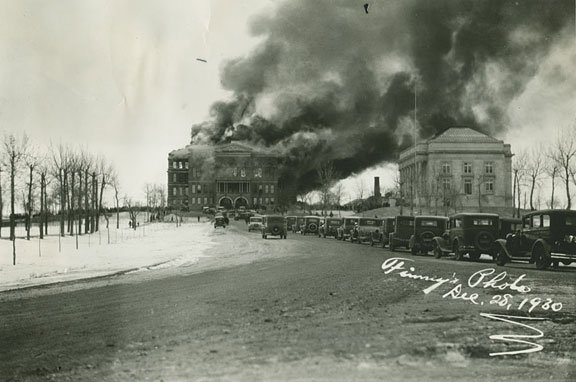North Dakota
State Capitol
Bismarck, North Dakota
1934
Bronze relief sculptures and brass elevator door designs with Holabird & Root
The North Dakota State Capitol is one of Edgar Miller’s most extensive art installation commissions. Located in Bismarck, the capitol building is well worth a journey for avid mid-century modern architecture fans. The capitol campus is comprised of six administrative buildings that cover over 160 acres. These buildings, constructed over the course of several decades, began as a project in the early 1930s after the first capitol was destroyed in a major fire.
The original North Dakota Capitol ablaze in winter of 1930.
The original North Dakota Capitol was built in 1883-84, in a Romanesque Revival style made popular by the famous American architect H.H. Richardson. A stately five-story structure of dark brick, the original capitol caught fire early one Sunday morning and was completely destroyed on December 28th, 1930. Opting against creating a replica of the original structure, North Dakota Governor George Schafer pushed for a completely modern design and construction, including a 19-story office tower to house all the government offices. Schafer's design was much more efficient than traditional capitol buildings which often utilize only 30% of their interior space for actual work functions. The new North Dakota capitol would go on to use over 80% of its interior space.
John W. Root and John A. Holabird, designers of the new capitol building, hired two of North Dakota’s premier architects, Joseph Bell DeRemer of Grand Forks and William Kurke of Fargo to oversee onsite architectural, engineering, and contracting work.
While local North Dakota architects are given credit for the building, Chicago firm Holabird & Root was also brought in to consult, and the aesthetic and structural results appear to be highly influenced by Holabird & Root’s art deco style, which they made popular in Chicago during the 1920s with buildings such as the Palmolive, the Board of Trade, the Chicago Daily News, and many more. Because of his close professional connection with Holabird & Root—with whom Edgar would work on several projects in the 1930s and ‘40s—Miller was brought on to do much of the interior design and decoration.
Miller's signature, an M with an arrow, hidden in plain sight on one of the brass elevator doors.
Miller's installed art is not merely decorative but tells the history of the land surrounding the capitol. Each figure on the front facade of the building depicts a piece of the history of the Dakotas: a Native American warrior defending his people’s lands; Sacagawea guiding Lewis and Clark through their exploration of the American frontier; a family of miners; White settlers entering the unknown and dangerous wilderness; and another Native American figure figure performing a ritual dance.
Relief sculptures on the building’s front facade depicting various figures of Dakota history.
While the people of the Dakotas have always taken a great deal of pride in their Native American heritage and relations, Miller's decision to depict Native American scenes on the capitol was progressive for the time. While American art deco designs borrowed heavily from Native American styles and motifs, much of the work of Miller’s contemporaries was both intentionally and inadvertently culturally appropriated. Miller, on the other hand, found himself identifying much more sympathetically with the Native American peoples and sought to exalt their stories and artwork whenever possible. Having been born and raised on the far western frontier of Idaho just after the turn of the century, Miller often spoke and wrote about his opposition to the mistreatment of Native Americans, especially throughout the 19th century when many tribes were completely wiped out by a systematic displacement policy of the United States. In his design work, Miller endeavored to integrate the stories of all peoples on North Dakota land, both indigenous and settlers, and from distant history to the modern day.
Miller's high relief sculpture of a miner above an entry turnstile.
Inside the building, Miller added highly detailed ornamental art above the turnstile doors. Above one, he created a depiction of the iconic Midwestern farmer and his livestock, and above the other, a miner and a set of backhoes. These images playfully remind visitors to the capitol of the two main industries that created the modern economy of the state.
Miller also executed brass relief elevator doors. These eight sets of doors for the first and second floors of the main hall again depict the history of the Dakotas: a cowboy and Native American in pitched battle; an explorer and buffaloes ranging; a miner and a ranch hand; and a farming family. Looking closer, in between the scenes are bands of even more detail: a railroad locomotive and a wagon train; herds of sheep and cattle; a farmer harvesting wheat and a Native American woman harvesting corn.
Above: Brass elevator doors with a vignette of intricately detailed scenes.
Below: Individual vignette details can be viewed in the picture carousel.
Although there is scant evidence to support the claim, some wonder whether Miller designed the interesting lighting throughout the building. The hanging lights are modeled after wheat stalks, the sconce lamps are designed to mimic the architectural elements found in King Tutankhamun’s tomb (discovered a decade before in 1922), and the ceiling light designs in the House and Senate chambers represent the motion of the moon and stars in the clear night sky over North Dakota.
Main hall of the capitol with lighting designed after wheat stalks.
North Dakota Legislative Chambers. The ceiling lighting design is meant to represent the eternal motion of the moon and stars as they travel overhead in the abundant night sky of the “Heaven State”.
Elevator banks on the second level, with balcony overlooking the main hall.
The North Dakota State Capitol, also known as “The Skyscraper on the Prairie” is located at 600 East Boulevard Avenue in Bismarck and remains the tallest inhabitable building in the state standing at 242 feet. The capitol is open for public tours on most weekdays and on federal holiday weekends. As one of the most well-crafted modernist buildings in the state, it’s well worth a visit while in town. For more information on visiting and tours, click here.


















